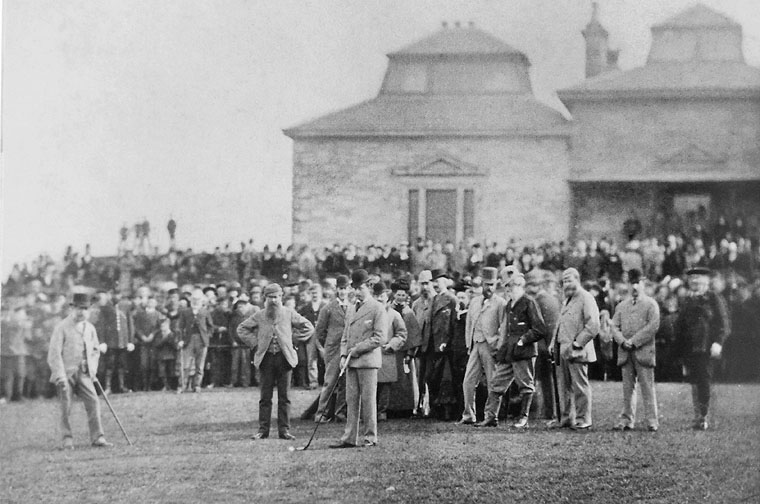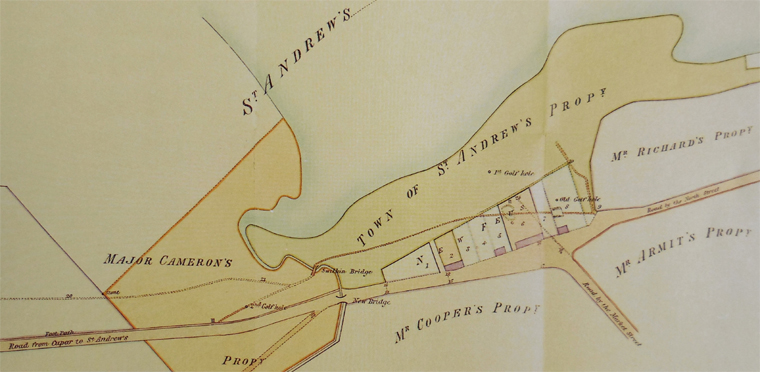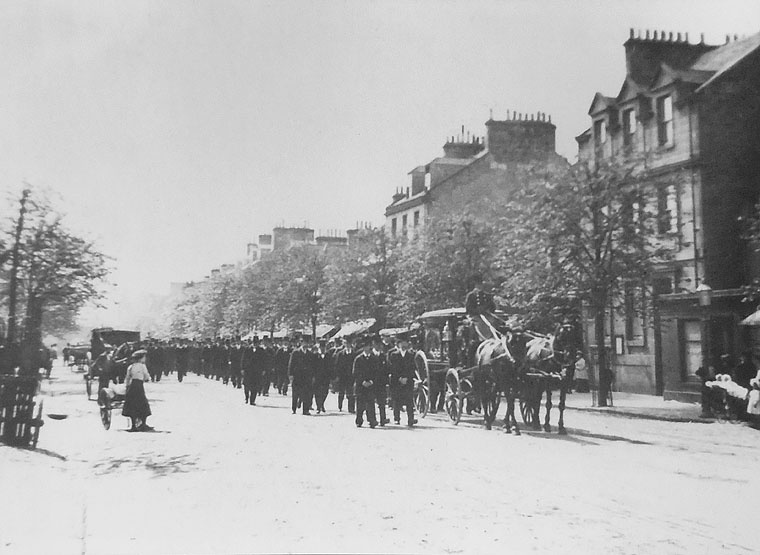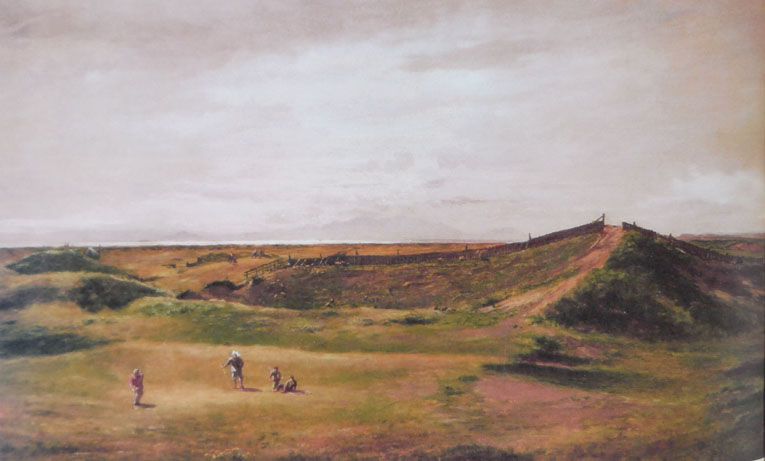Feature Interview with Old Tom Morris
December 2013

Old Tom Morris squired many a person around the Old Course. His playing companion on this day in 1876 was Prince Leopold.
Is there anyone who can match Tom Morris’s all encompassing influence on the game of golf? He played an important role in every segment of the game from equipment to green keeping to the rules and golf course design. He was dominant in the evolution of the game, gracefully presiding over the two bastions of the game, Prestwick and St Andrews during seminal periods in the sport’s development. After his return to St. Andrews in 1865 from Prestwick he became the custodian of the Home of Golf and he hosted many of the men who formed the backbone of the Golden Age of Architecture, including Harry Colt, Charles Blair Macdonald, A.W. Tillinghast and of course, his apprentice, Donald Ross. Some consider Old Tom the first agronomist; others the first golf course architect. All appreciate that he was an ace player; he won the Open four times. He routinely played in it through the age of 76, exposing most professionals today as wimps. He may have been the greatest golf instructor as his protege and son, Young Tom was surely the world’s greatest player before his untimely death on Christmas day at the age of 24. Somewhat sadly, Old Tom outlived his entire family but that became Golf’s blessing as this stately gentleman embodied all that was good about the game and spread that goodness among the kingly as well as the plebian. Without doubt he rightly achieved the sobriquet of a recent biography- “The Colossus of Golf.”
You were born in 1821. How have clubs changed over your lifetime?
Clubs! I fear there will be a great many players nowadays who will not recognise the clubs which constituted a full set, in my young days – drivers, long spoon, mid spoon, short spoon, baffy spoon, driving wooden putter, ordinary wooden putter, wooden niblick with or without brass sole, a cleek, and sand iron. All wooden, it will be observed, except the last two. Nowadays these relative positions are almost completely reversed. Many good players now carry only three wooden and as many as seven or eight iron clubs in their bags – an article, by the way, we did not think of in those days. The different spoons in the old set mentioned above corresponded pretty much to, and did the work of the present mashie, the different irons, and the cleek, but they were not nearly so hard on the turf as these later implements are – there was not nearly so much divot-lifting then.
The shape of the wooden club heads was very different then. The driver was long and narrow, now it is short and broad, or almost round, we might say. I should perhaps add here that although the latter description of club has been in vogue many years now, and for a considerable time before I gave up playing regularly, I never took to the newer, short-headed wooden club at all, always preferring to use one with the old fashion long narrow head. Of the two iron clubs in the old set, the cleek was not the unlike that of the present day, except that the head was perhaps longer; but what we called the sand iron has now gone out of use. It was something of the shape of the modern iron, but very much broader, longer, and heavier. And was a formidable weapon, but good and very useful. It would, of course, be superfluous to say anything of the up-to-date set; they are well known. The difference between the two sets is very marked.
You have never much cared for irons, have you, because of how they gouge the turf?
I consider iron clubs are greatly detrimental both to golf and to the greens – to golf because players bring into use so many different tools: indeed iron clubs are now so varied that players sometimes get confused amongst them.
How about the ball?
During my lifetime I have seen three eras of golf balls – the feather, the gutta, and the rubber-core. I ought to know about balls, for I was a maker of them in my youth, first in the workshop of my friend and partner in many a foursome, the famous Allan Robertson, and afterward on my own account. When I first started, of course, it was with the feather balls, and as the art of making has gone completely out of existence, it may be interesting to briefly explain how they were made. The cover was in the form of a little bag or pouch of bull’s hide, specially cured and prepared with alum, and into this we put as many feathers as we could, with the instruments we had for the purpose. These little bags held a wonderful lot of feathers when tightly packed. Then, when the cover would hold no more, we sewed up the opening, and the ball was complete.
What were the ramifications of the gutta?
Although the gutta is a decided improvement on the ‘feathery,’ the latter, in my opinion, flew as far as any gutta ever did. Of course, when the gutta came in the ball was rendered cheaper, and consequently, this led to the game becoming more popular.
Talk to us about how you made a gutta ball.
The gutta ball appeared first with a perfectly smooth surface. It was shortly found that they flew better after they had a number of hacks and dents from the club upon them, and this fact gave to someone the idea of hammering them. This was done by the hand with a small heavy hammer, shaped at the reverse side like a chisel. With this tiny channels on the ball were made, the latter being during the process held by the left hand and turned round in a small wooden cup fixed in front of the worker, and very neat patterns, too, used to be put on the ball in this way. After a time the corrugated mould, in all its varieties, was brought into use, and superseded all other methods. So we have had the feather and then the gutta ball, and now we have the rubber –core, but what further changes are yet in store in this direction for the golfer of the future no one can say.
Mr. Robertson and you were a formidable team. Do you have a favorite match you can share with us?
Of course we had our matches in these old days as professionals have now, but it is not for me to talk of them in detail here, though I well remember them, and grand tussles they were all. But there is just one point in connection with them that I would mention, and it is that the results of the big matches of that time were more frequently reckoned by Greens than, as nowadays, by Holes. I will tell of one as an example of what I mean. Allan Robertson and I played a match against the two Dunns over Musselburgh, North Berwick and St Andrews. Now while we were very heavily beaten at Musselburgh, we won at both the other Greens, and were reckoned as winners by two Greens to one, although we had lost counting by Holes. This is a custom which has now gone entirely out of vogue.
What caused the split from your friend and mentor Robertson?
It was while I was yet working with Allan Robertson that the gutta came in, and special reason, too, I have of remembering its advent, for it was the cause of my leaving my friends employment. One day, while playing a match, a gentleman lent me one of the new balls to try, and I found it very good. I spoke highly of its merits; someone told Allan of this, and he, as a feather ball maker, having a special antipathy to the innovation, we had words when next we met, which ended in my leaving him and starting on my own account.
What do you make of the rubber core ball that has come out around the turn of the 20th century?
I have used the rubber-core but seldom, for my regular playing was well nigh over when it came into the field. Such, then, are the alterations that have come over the implements of the game within my time and knowledge, and I can only hope that they have added, and that further changes also will add, to the greatest pleasure of the greatest number of those who play our game.

Old Tom Morris doesn’t receive enough credit as a golf course architect. Just consider some of the fantastic holes and features that he created at Prestwick. Above is J Smart’s 1889 watercolor of the Cardinal bunker.
How many golfers were there when you were growing up?
Why, when I was a young man, even in St Andrews here, where to-day practically everyone plays to some extent, the golfers were a small minority of the population and we had very few visitors who came here for the purpose of playing golf. In these days I have frequently heard golfers described us men with “mair siller than sense” and even to-day there are people, ill-natured probably, who will yet say so, but, of course, they are wrong.
How about in 1907?
What a difference here now – every day there are many playing even in the winter, while in July, August, and September the congestion on our Links is a matter of common knowledge; and through we cannot, of course, but rejoice at the great number who now play, still the fact does not tend to increase the pleasures of the game, for there is nothing like getting a round played without any undue waiting for allowing as to draw the full pleasures therefrom.
Another marked difference now, and the natural sequence of above, is the enormously increased number of courses, and we are constantly reading of new ones being laid out and opened. At one time there was a comparatively limited number of courses, all fairly well known; now there is scarcely a town but has one of its own of some kind or another.
How has the Old Course evolved during your life time?
It is the great alteration which has come over our grand old course here – so long under my personal charge, and of which I am still so proud – since first I knew it. I say this has more of a local aspect than my other observations, but not so much after all, because there must now be quite a large percentage of the golfing world who have at some time or other in their experience visited and played over our famous Links, and thus know what they are like and have been for the past dozen years or so.
But they were once very different, as I remember well, and I fear those who know them now would scarcely recognise them, if it were possible that they could be carried back to those old days and shown what was then our golf course. There was but one, as it was only within comparatively recent years that new course was made. Where it now is was then all grown over with thick, high whins, intersected by winding paths; in fact, all outside the course was then just a waste of links or downs. And that one course was not the wide one that we know now, for the whins came very much closer in at the sides; indeed, when I first remember it, there was but one single line of Holes and putting Greens, so that both the outgoing and incoming golfers had to play at the same Hole – in those days not much of a hardship, when the players were, as I said, comparatively few, but quite impossible now, when there is a crush and congestion here in the summer, although we have three courses open for play.
Any other change stick out regarding the landscape of the Old Course as you stroll around her with your collie Silver?

A. Martin depicted this diagram in 1821 which is the very year that Morris was born in St. Andrews. It’s safe to say that Old Tom Morris saw and was involved with many changes to The Old Course throughout his life!
Another local change I might note, that when I was young man there was no clubhouse for the Royal and Ancient Club, and the members first found house room in a small one story house near the Links. Now they have their present fine building, begun to be built in 1854, and a membership that is world-wide, as is its influence on the game.
What’s your preference – the game as you grew up or the game of 1907 with the rubber core ball? Is golfer a better or worse game for all the changes?
My opinion is possibly biased, but I must confess that, no matter how much I admire the Braids, Taylors, and Vardons of today, and no matter how I appreciate all the improvements that have come into the game, still round the good old days, with all their dear associations, and fond memory ever clings, which almost makes me hazard the opinion that they were the best days of all.

Old Tom Morris passed away in 1908. The size of the funeral procession only begins to hint as to what he meant to the town of St. Andrews and to golf as a whole.
Editor’s note: Old Tom Morris’s above replies are verbatim from two articles kindly provided by Melvyn Morrow, one from the Evening Telegraph on June 15th, 1901 entitled A Chat with Old Tom Morris – The Nestor of Golf and the other A Veteran’s Reminiscences from the Dundee Courier on 21st June 1907.
The End











